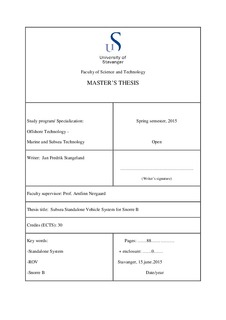| dc.contributor.author | Stangeland, Jan Fredrik | |
| dc.date.accessioned | 2015-09-30T13:57:39Z | |
| dc.date.available | 2015-09-30T13:57:39Z | |
| dc.date.issued | 2015-06-15 | |
| dc.identifier.uri | http://hdl.handle.net/11250/1238530 | |
| dc.description | Master's thesis in Offshore technology | nb_NO |
| dc.description.abstract | The rig manager on Snorre B, a semisubmersible production and drilling rig for Statoil, has expressed the need for a subsea standalone vehicle that can perform specific tasks when the conventional remote operated vehicles (ROV) is not capable of diving due to rough weather. This is seen especially during the winter season. Having a vehicle in standby at the subsea location, during all-weather situations, will enable critical work to be performed on the subsea structures and increases safety, such as operating valves during emergencies.
By analyzing the ROV operation that have been affected by bad the weather, the main restrictions was fond in the launch and recovery of the ROV system, due to the large wave forces acting on the system during this operation.
If the standard launch and recovery system for the ROV could be removed or altered, a new system could be designed. It was found that if the hangar and vehicle where to be placed on the seabed during calm weather conditions and they could remain there for longer periods during rough weather, this would decrease down time during a possible malfunction.
The standalone system would need to remove the weather depended components in order to work during rough periods. This was achieved by changing out the way the ROV communicates and receives electrical power. By receiving power from subsea structures, and signals from a high weather tolerant piggyback solution, the standalone system can be operated during any storm the rig`s umbilical and risers can take.
The standalone components, which consist of a hangar and the vehicle, is connected through different types of tethers; power and signal tether, optical fiber tether, and wireless connection. These connection types give the vehicle the means for reaching and completing the required types of operations. | nb_NO |
| dc.language.iso | eng | nb_NO |
| dc.publisher | University of Stavanger, Norway | nb_NO |
| dc.relation.ispartofseries | Masteroppgave/UIS-TN-IKM/2015; | |
| dc.rights | Navngivelse 3.0 Norge | * |
| dc.rights.uri | http://creativecommons.org/licenses/by/3.0/no/ | * |
| dc.subject | Snorre B | nb_NO |
| dc.subject | ROV | nb_NO |
| dc.subject | offshore teknologi | nb_NO |
| dc.subject | standalone system | nb_NO |
| dc.subject | marine and subsea technology | nb_NO |
| dc.subject | undervannsteknologi | nb_NO |
| dc.title | Subsea standalone vehicle system for Snorre | nb_NO |
| dc.type | Master thesis | nb_NO |
| dc.subject.nsi | VDP::Technology: 500::Marine technology: 580::Offshore technology: 581 | nb_NO |

